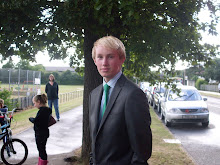
Contents page analysis
The colours of this contents page of "Q" is conventional to the magazine, red, white and black are used in many music magazines to produce the rock star image. This pages design separates the pictures from the main texts, features and monthly features are in a left hand column, with images taking up the vast majority of the rest of the page. There are two images on this page, the first is of "The Courteeners" and the second is of "Nick Cave". In the "Courteeners" image they are standing casually on a grassy hill, they are all wearing jeans and t-shirts and all have long scruffy hair which equals a stereotypical image of a rock star. Words are used here to stand out to the consumer, they are all in Capitals and all the important headings are in bold for example "REVIEW" stands out to the reader so they can know what to expect. The language used is short, informing words that will give the reader an insight into the magazine such as "every month" to show what's happening once again in the magazine which appears every month. Also quotes are used such as "he's just showing off". The overall impression is a good one, you are being informed of the contents as well as constantly having the conventional magazine style thrown at you due to colours and images.
The colours used on this contents page are gold black and white, this is unique to the "Kerrang" magazine and this shows it is different to other music magazines with their conventional red, white and black, the colours also stand out to the consumer. The design of the page is very busy, the images and the texts are once again separated, but tightly packed with many small images cramped together. There are 11 small images cramped together on the page of varied artists and bands including "Slipknot". All poses are of either the bands or artists singing together or posing as a group especially for the magazine.The lettering's are varied between capital and lower case and bold. This stands out to the reader and key events that most people would want to read are instantly seen. The language used is plain information, it informs the reader as to what is inside and includes the snippets of the articles. The overall impression of this contents page is OK, it could be improved by larger snippets to entice the reader more into varied articles and unconventional but bold colours and different text styles stand out to the reader and can entice the reader without extracts.
The colours on this contents page are conventional to NME, black white and red are constantly used by this magazine to produce the rock star image. Once again the words fit around the picture which creates a busy but factual page. The image is unconventional to contents pages as it is of a venue rather than a band. a "tribute to three decades of gigs at one of the world's greatest music venues" "The Astoria". The words on the covers are as usual in bold capitals, this brings back NME readers from previous issues. The language used is typical to music magazines with words such as "Live" giving the effect of being at a gig watching the bands live. The overall impression from this contents page is a bit dull, it does stand out to the reader and does unconventionally use a picture of a venue rather than a band, however the conventional colours of NME have been seen before and are not particular exciting combined with the design.





